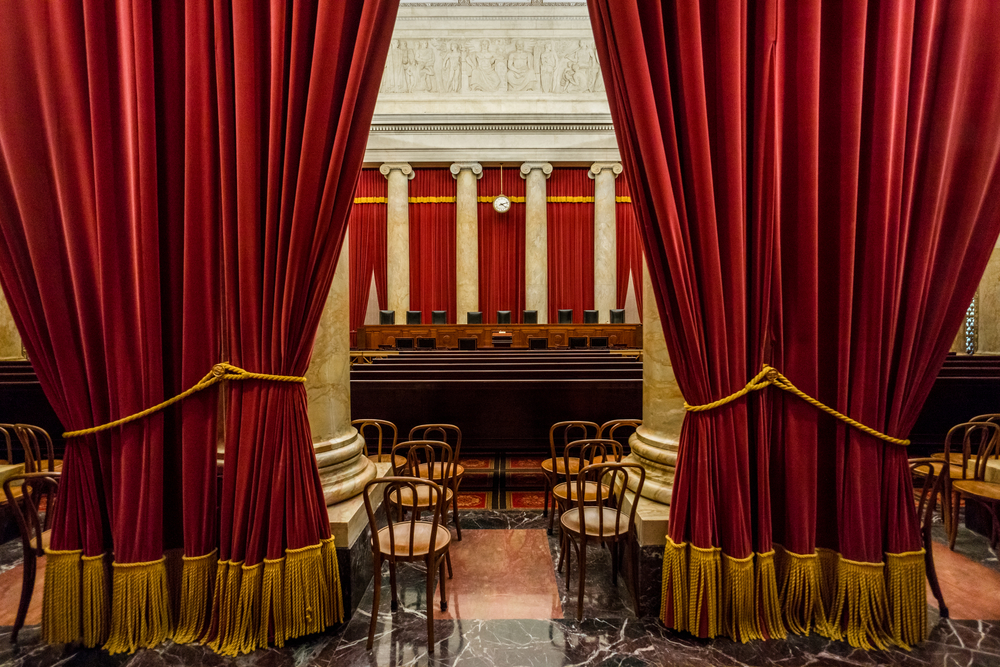Idea of court packing gains traction among some Democrats; are there alternatives?

Image from Shutterstock.com.
Some Democrats are considering the idea of court packing—adding seats to the U.S. Supreme Court—as President Donald Trump moves quickly to fill the seat vacated with the death of Justice Ruth Bader Ginsburg.
The Constitution doesn’t specify how many judges should sit on the Supreme Court. Instead, the number is set by statute. If the Democrats gain control of the Senate after the election, they could make the change.
The Washington Post, NPR, BuzzFeed News and Politico have coverage.
Those who support adding justices to the court cite hypocrisy by Republicans who refused during an election year to consider Judge Merrick Garland, President Barack Obama’s Supreme Court nominee, in 2016.
“The Republicans packed the court after [Justice Antonin] Scalia’s death when they denied President Obama his choice,” said Brian Leiter, a professor at the University of Chicago Law School, in an interview with NPR. “Now they want to pack it further and more consequentially, given that they would appoint a conservative to replace the liberal Ginsburg. If they pack the court, the Democrats would be crazy not to do their own court packing.”
One plan, known as the “5-5-5” plan, would increase the size of the Supreme Court from nine to 15 justices. Five would be affiliated with the Democratic Party and five with the Republican Party. The remaining five would serve one-year terms and would be chosen from among circuit and possibly district judges by unanimous or supermajority vote by the 10 political justices. If the 10 justices can’t agree, the Supreme Court would lack a quorum and be unable to decide cases.
Law professors Daniel Epps of the Washington University in St. Louis and Ganesh Sitaraman of the Vanderbilt Law School wrote a Yale Law Journal article proposing the idea.
According to the Washington Post, the Supreme Court “expanded and shrank like an accordion” in the Civil War era as Congress sought to give extra appointments to Presidents Abraham Lincoln and Ulysses S. Grant and to shut out President Andrew Johnson from making any appointments. The number of justices has not changed since Congress set the number at nine in 1869.
President Franklin Delano Roosevelt sought to expand the court when it was striking down his New Deal legislation. His plan was to get congressional authorization to appoint a new judge for every federal judge older than 70. Congress balked, but two justices began switching their votes to support Roosevelt’s legislative agenda.
Many candidates in the 2020 Democratic presidential primary previously told the Washington Post that they would be open to the idea of adding justices to the court. They include current Democratic vice presidential nominee Kamala Harris, a U.S. senator from California.
But Democratic presidential nominee and former Vice President Joe Biden told the Washington Post that he is opposed to the idea. He made the same point in an interview with Iowa Starting Line last year.
“I’m not prepared to go on and try to pack the court because we’ll live to rue that day,” he said. “We add three justices. Next time around, we lose control, they add three justices. We begin to lose any credibility the court has at all.”
Ginsburg herself was troubled by the idea.
“If anything would make the court look partisan,” she told NPR last year, “it would be that—one side saying, ‘When we’re in power, we’re going to enlarge the number of judges, so we would have more people who would vote the way we want them to.’ ”
Increasing the size of the court isn’t the only alternative. Epps and Sitaraman also propose a second “Supreme Court lottery” plan, which would appoint every judge on the federal courts of appeals as an associate Supreme Court justice. Cases would be heard by a panel of nine, randomly selected from among the judges. Each panel could not have more than five judges nominated by a president of a single political party.
Law professors Samuel Moyn of the Yale Law School and Ryan Doerfler of the University of Chicago Law School outline other alternatives in a paper written in July and that will be published in the California Law Review.
They discuss these ideas:
• Strip courts of authority to hear certain cases. Some suggest insulating specific legislation from judicial review, such as the Green New Deal or Medicare for all, or insulating specific classes of cases, such as those involving abortion or gun control. Some have called for an even more sweeping ban that would prohibit courts from reviewing the constitutionality of any legislation. The legislation could ban courts at certain levels from hearing cases or could leave jurisdiction with the executive branch.
• Require a supermajority of justices to declare federal legislation invalid. “Such a requirement would transfer power from the judiciary to the political branches in uncertain constitutional space,” Moyn and Doerfler wrote.



